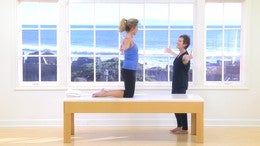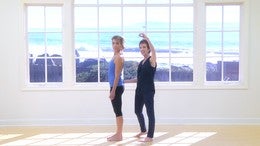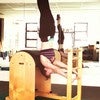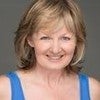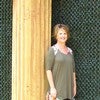Description
About This Video
Transcript
Read Full Transcript
I'm difficultly. I'm visiting polities anytime from Boulder, Colorado. I'm here today to share with you yet another of the gems that I learned from Eve gentry. This one's called paint the ceiling. On a most basic level, this is good for relieving Napkin jaw tension and improving your posture. But what I've realized as I've played with this exercise over time and really worked with the imagery, is that it's an incredible way to get your spine to move in all different directions in such a way that if you tried to tell yourself to do it, you could never do it. So the power and the magic of this is working with the imagery.
So I invite you to do this with me. I'm going to be closing my eyes the whole time because it's impossible for me to do it with my eyes open. So join me if you will. Imagine that you are in a huge cathedral with a hundred foot vaulted ceilings and your job is to paint the ceiling. So you have this paintbrush that's attached right to the top of your head coming right out from the center of you reaching up and up and up all the way so that you can touch the farthest reaches of the ceiling and you choose your colors. And in a very general way you start to paint the ceiling and you picture the arc of the ceiling. So perhaps the first several passes with your paintbrush, you're going back and forth, side to side reaching and really imagining the color, seeing the ceiling as you paint.
You have to really find a way to lift that paintbrush, which is a long and therefore heavy so that it reaches and paints the every bit of that ceiling. And then you might take yourself forward and back and again, really seeing the paintbrush, lifting the weight of the paintbrush up, seeing the paint on the ceiling forward and back, another couple side to side. And then you might do some circles and as you circle it's really nice doing it on this ball. It's different than if I were standing up. Cause you start to feel how the movement actually transfers all the way down through your body. And then you might take that circle in the other direction.
And then another lovely thing to do, let's go back to the side to side motion, is to paint figure eights in that same plane. So you're reaching up to the ceiling in this way and then you see it helps me a lot to visualize. So the figure eight that you're working with is in this plane. You're not doing it in front of your face, right? You're doing it up there and as you do this figure eight and you stay very clear picturing it in your mind's eye.
But knowing that you are reaching up into the top of that paintbrush, it's amazing the mobility and ease with which you can get the movement to flow through your spine, down through your hips, knees, ankles and feet. And then of course it's always nice to go back the other way and reverse your direction and really feel how you can get all the way into the farthest reaches and edges. So that you don't have any part of the ceiling left without paint and then come back. Going back to the forward and back one, you take your figure eight in this plane now, so it's doing this different arrangement. If I were to try to tell myself exactly what I'm doing with my body, I would never be able to do it. And then the reverse.
It's really nice on the ball I usually do at standing, but this is really great because you just get all this lovely motion. I'm, if you are watching, I am trying to model it with my hands to help not only to show you but to keep myself able to focus and then we go back to the top and we taught, we had done some, some general circles. You can circle over to one side, maybe you moved your ladder over, you can circle one side. You could circle the other side. And of course guess what that does takes you into a figure eight which is now lying on top of your head.
Way Up there. And then let's go the other way. Retracing, seeing the figure eight in your mind's eye.
One of the things that's nice about the circle, Millennia really any of it, but as I was doing it, I was feeling that it would be nice to stand up because one of the things that's nice about the circle that's just overhead. If you, if you remember or if you've got to watch the tutorial that I did with Christy last year on the dynamic posture and we talked about Eve's verticals hanging in the horizontals floating and the plum line. So now taking it into standing, it really feels wonderful. You have this whole new relationship to your feet and your ankles and so you can again go back to that. You can circle around one side and it's, it's marvelous.
You get this whole new relationship to the space in your hip. You can circle the other side. And so from here I want to take you into one more of Eve's imagery. Gems, which is essentially doing figure eights and circling around your hips. But the images that you're, you're tying a bow. So you again, you have to use your imagination. So it's like a big bowl on a package.
So you've got the two loops and then you have the, the strings that come down. So to get going again, you can just start with one of your loops, right? So you just be, feel that because you see it, you see yourself circling around your hips, circling around your hip and then you can go the other way. Circling around the hip and you have your other hips circling around the hip
If I tried to tell myself to get this movement in through my hips and my, I don't know what I would say, but I'm so clear on, you know, learning to tie your shoes with the bunny ears and then you feel like you can just get so much release in through your hip, your knee or ankle because you see things going through the centers of your hips. And one, one more little piece of this, which is actually very much fun. It's so instead of seeing the figure eight and bow on the front, this I made up, it's, it's a little bit of a gross image, but it's okay if you, uh, if you had a big hard boiled egg in your hip and you sliced the egg this way, you'd see half of the yolk looking up at you and half of the oak looking down. And so that is another way to just kind of imagine those two things coming together. So you see your hard boiled egg and you see those two bits of the two faces of the yoke on each other. And it's a way of really learning to be in your pelvis, released all the way through your hips, your knees and your ankles.
But it's lovely. It's not technical and putting all that together, it just, I hope you did some of that with me cause I'm good to go.
Comments
a real dance no for spectacle
thank you debora you are a source of inspiration
You need to be a subscriber to post a comment.
Please Log In or Create an Account to start your free trial.
